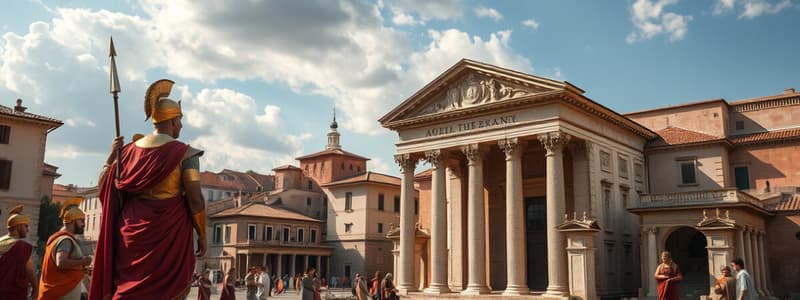Podcast
Questions and Answers
What was the time period of the Monarchy in Rome?
What was the time period of the Monarchy in Rome?
- 27BC - 476AD
- 509BC - 27BC
- 716BC - 673BC
- 753BC - 509BC (correct)
What years did the Republic in Rome cover?
What years did the Republic in Rome cover?
- 27BC - 476AD
- 753BC - 509BC
- 509BC - 27BC (correct)
- 641BC - 616BC
What was the time period of the Roman Empire?
What was the time period of the Roman Empire?
- 673BC - 641BC
- 27BC - 476AD (correct)
- 509BC - 27BC
- 753BC - 509BC
Who was the first king of Rome?
Who was the first king of Rome?
What notable event is Romulus known for?
What notable event is Romulus known for?
Who was the second king of Rome?
Who was the second king of Rome?
What was Tullus Hostilius known for?
What was Tullus Hostilius known for?
What major contribution did Ancus Marcius make as king?
What major contribution did Ancus Marcius make as king?
Who was the fifth king of Rome?
Who was the fifth king of Rome?
Flashcards are hidden until you start studying
Study Notes
Monarchy and its Timeline
- Monarchy period from 753 BC to 509 BC marked the rule of seven kings in Rome.
The Roman Republic
- Republic era spanned from 509 BC to 27 BC, transitioning from a monarchy to a government led by elected officials known as consuls.
- Early Republic focused on the conquest of the Italian peninsula, while the Late Republic expanded Rome's influence to other territories.
The Roman Empire
- Empire period extended from 27 BC to 476 AD, characterized by centralized power and territorial expansion.
Romulus (1st King)
- Ruled from 753 to 716 BC; founder of Rome; kidnapped women from Sabines for population growth.
- Established the Senate and divided citizens into warriors and non-warriors.
- His death is shrouded in myth; believed to have ascended to heaven or been murdered by senators after a 40-year reign.
Numa Pompilius (2nd King)
- Reigned from 715 to 673 BC; chosen to rule to fulfill Sabine requests.
- Established religious practices and formalized rituals, including the introduction of the Vestal Virgins.
- Reformed the calendar from 10 to 12 months and constructed the Temple of Janus, which symbolized peace and war.
Tullus Hostilius (3rd King)
- Ruled from 673 to 641 BC; known for his military aggressiveness unlike his predecessor.
- Defeated Alba Longa, resolving the conflict through a contest of combat between brothers.
- Built the Curia Hostilia, a larger Senate house, and faced divine retaliation when lightning struck him after a plague.
Ancus Marcius (4th King)
- Reigned from 641 to 616 BC; involved in the defeat of the remaining “Old Latins.”
- Fortified the Aventine and Janiculum hills, integrating them into Rome.
- Credited with the construction of the first aqueduct and establishing the port city of Ostia, enhancing trade routes.
Tarquinius Priscus (5th King)
- Ruled from 616 to 579 BC; an Etruscan who brought cultural influences to Rome.
- Legend tells of a prophetic eagle that took his hat upon his arrival in Rome, signifying his destiny.
General Context of the Kings
- Each king significantly contributed to the social, political, and military foundations of Rome, shaping its evolution from a small city to a powerful entity.
Studying That Suits You
Use AI to generate personalized quizzes and flashcards to suit your learning preferences.




